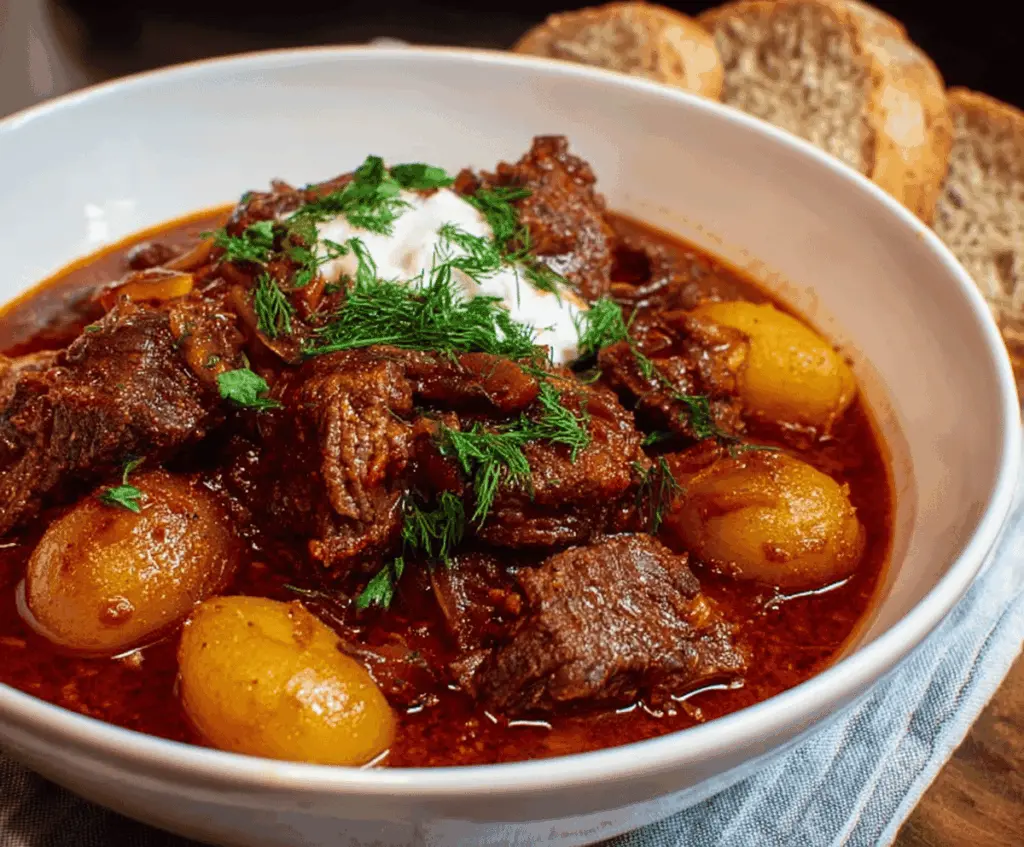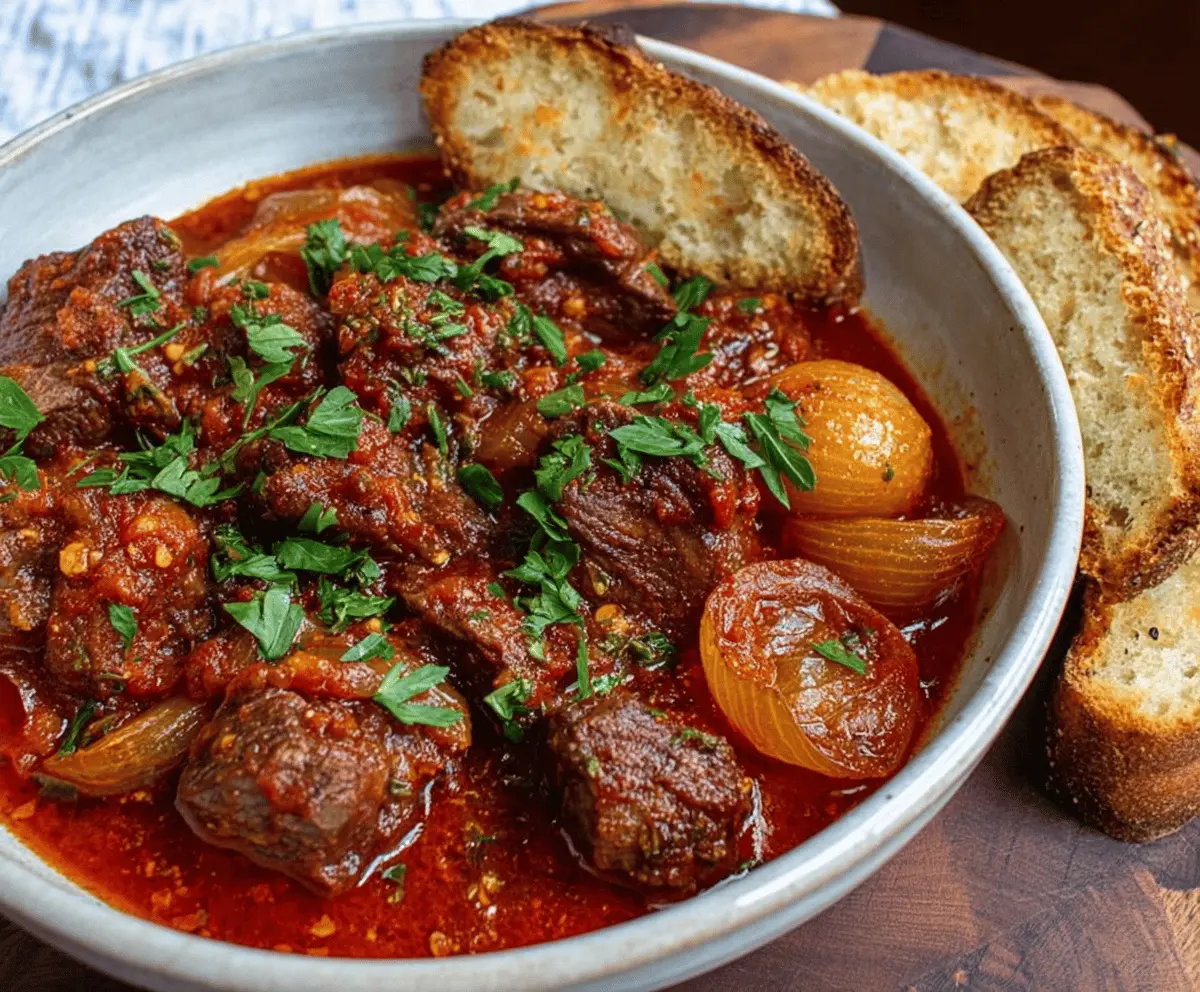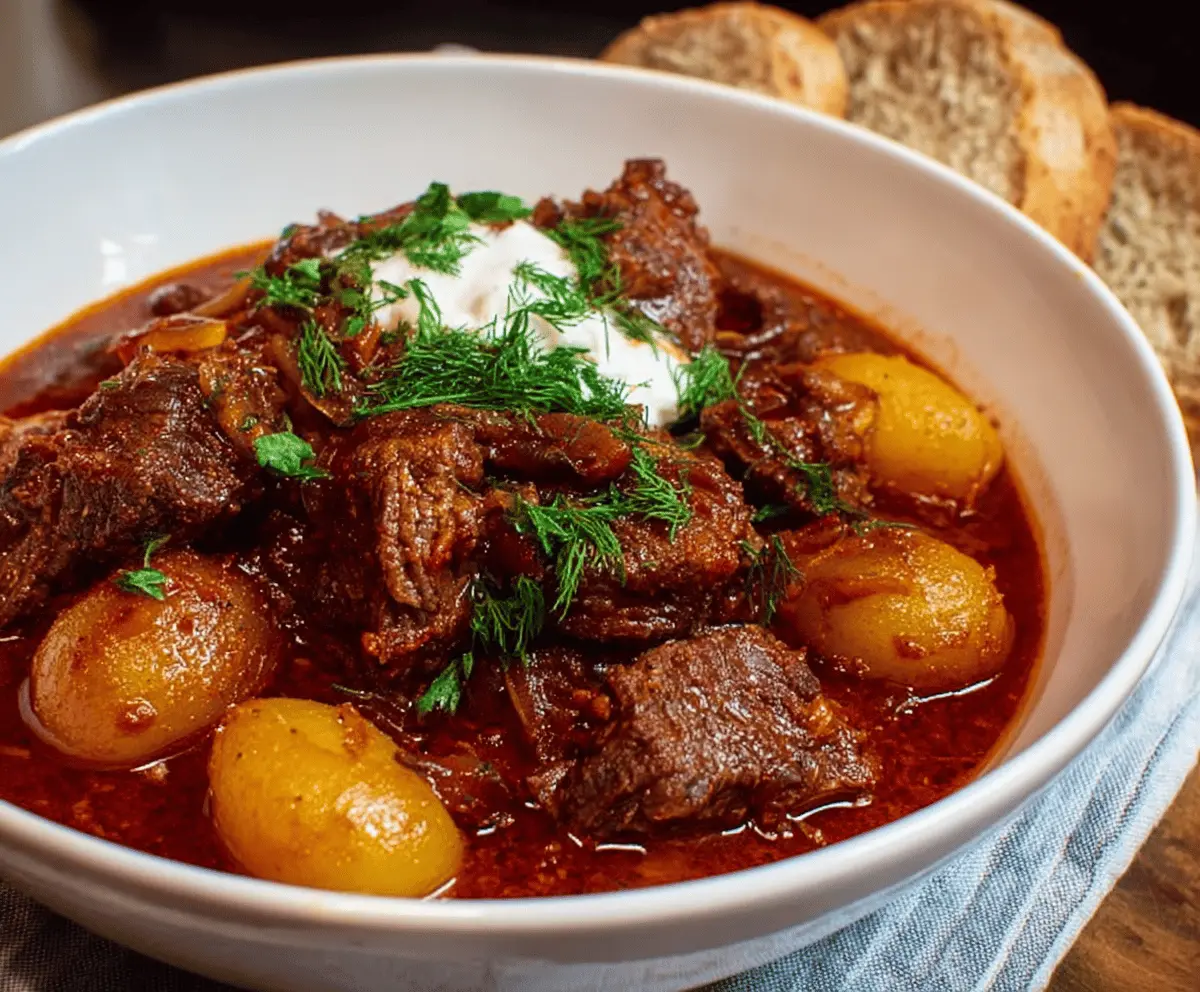
Greek Beef Stew
Greek Beef Stew is a hearty and comforting dish packed with tender chunks of beef, bright tomatoes, and earthy herbs like oregano and thyme. It’s a simple, rustic stew that…
Tip: save now, cook later.Greek Beef Stew is a hearty and comforting dish packed with tender chunks of beef, bright tomatoes, and earthy herbs like oregano and thyme. It’s a simple, rustic stew that brings together flavors that are both fresh and satisfying.
I love making this stew on a cool day when the whole house fills with the smell of simmering beef and herbs. It feels like a cozy hug in a bowl, and I always make sure to cook it low and slow so the beef gets melt-in-your-mouth tender.
My favorite way to serve Greek Beef Stew is over a bed of creamy mashed potatoes or with warm, crusty bread to soak up all the delicious juices. It’s one of those meals that’s great for sharing with family and friends, and it always seems to bring everyone closer around the table.

Key Ingredients & Substitutions
Beef chuck: This cut is perfect because it becomes tender and flavorful when slow-cooked. If you can’t find chuck, you can use brisket or short ribs for similar results.
Olive oil: Essential for authentic Greek flavor. If you prefer, you can substitute with vegetable oil, but olive oil adds a nice fruitiness.
Crushed tomatoes: They add richness and body to the stew. You can use fresh tomatoes blended or canned diced tomatoes as an alternative.
Red wine (optional): Adds depth to the flavor, but you can skip it or use extra beef broth if you prefer not to cook with alcohol.
Small waxy potatoes: These hold their shape well while cooking. Yukon gold or fingerling potatoes work well too. You can omit them if you want a lighter stew.
Fresh dill: A classic Greek herb that adds brightness. If you don’t have dill, parsley or mint are good substitutes.
How Do I Get Tender, Melt-in-My-Mouth Beef?
Slow cooking is key! Here’s my tip to get beef perfect every time:
- Start by patting the beef dry and seasoning well. This helps you get a good sear.
- Brown the beef in batches so it gets a nice caramelized crust. Don’t overcrowd the pot!
- Simmer the stew gently on low heat for at least 1.5 hours before adding potatoes. This breaks down the connective tissue.
- Adding potatoes at the right time ensures they don’t fall apart before the beef is tender.
Patience during cooking makes all the difference – the beef should shred easily with a fork when it’s ready!
Equipment You’ll Need
- Heavy-bottomed pot or Dutch oven – perfect for even heat and slow cooking your stew to tender perfection.
- Sharp chef’s knife – essential for chopping onions, garlic, and trimming beef cleanly.
- Wooden spoon – great for stirring the stew without scratching your pot.
- Tongs – help you turn and brown the beef cubes easily and safely.
- Measuring cups and spoons – to get your herbs, liquids, and seasonings just right.
Flavor Variations & Add-Ins
- Swap beef for lamb – it adds a richer, more traditional Greek taste to your stew.
- Add carrots or celery – these bring extra sweetness and texture to the stew.
- Stir in crumbled feta cheese before serving – it gives a tangy, creamy boost that pairs well with the herbs.
- Mix in a pinch of cinnamon or allspice – these warm spices lend a subtle Middle Eastern twist.

How to Make Greek Beef Stew
Ingredients You’ll Need:
- 2 lbs beef chuck, cut into 1.5-inch cubes
- 3 tbsp olive oil
- 1 large onion, chopped
- 3 cloves garlic, minced
- 1 can (14 oz) crushed tomatoes
- 1 cup beef broth
- 1/2 cup red wine (optional)
- 1 tbsp tomato paste
- 1 tsp dried oregano
- 1 tsp dried thyme
- 1 bay leaf
- Salt and freshly ground black pepper, to taste
- 1 lb small waxy potatoes (or baby potatoes), peeled if desired
- Fresh dill, chopped for garnish
- Greek yogurt or sour cream, for serving
- Fresh parsley, chopped (optional garnish)
- Crusty bread, for serving
How Much Time Will You Need?
This dish takes about 20 minutes for preparation and browning the beef, then about 2 hours of gentle cooking time to get the beef tender and the potatoes soft. So, plan for roughly 2 hours and 20 minutes from start to finish, including simmering time.
Step-by-Step Instructions:
1. Brown the Beef:
Heat 2 tablespoons of olive oil in a heavy pot or Dutch oven over medium-high heat. Dry the beef cubes well and season with salt and pepper. Brown the beef in batches until nicely seared on all sides, about 5 to 7 minutes per batch. Set browned beef aside.
2. Cook Onions and Garlic:
Lower heat to medium and add the remaining tablespoon of olive oil. Add the chopped onions and cook, stirring, until soft and golden, about 5 minutes. Stir in minced garlic and cook for 1 more minute until fragrant.
3. Build the Stew Base:
Mix in tomato paste and cook for a minute. Then add crushed tomatoes, beef broth, and if using, red wine. Scrape the pot bottom to loosen any browned bits — this adds great flavor.
4. Simmer the Stew:
Return the browned beef to the pot. Add oregano, thyme, bay leaf, salt, and pepper. Bring to a gentle simmer, cover, and cook over low heat for about 1.5 hours, until the beef starts to get tender.
5. Add Potatoes and Finish Cooking:
Add the small waxy potatoes, cover again, and cook for another 30 to 45 minutes until beef and potatoes are fully tender. Remove the bay leaf and adjust seasoning as needed.
6. Serve Warm and Garnished:
Ladle stew into bowls. Add a spoonful of Greek yogurt or sour cream on top, and sprinkle with fresh dill and parsley if you like. Serve with crusty bread to soak up the delicious juices.

Can I Use Frozen Beef for This Stew?
Yes, but make sure to fully thaw the beef in the refrigerator overnight before cooking. Pat it dry to remove excess moisture for better browning.
Can I Make This Stew in a Slow Cooker?
Absolutely! After browning the beef and sautéing the onions and garlic, transfer everything to a slow cooker. Cook on low for 6-8 hours or until the beef is tender. Add the potatoes during the last hour to avoid overcooking.
How Should I Store Leftovers?
Store leftover stew in an airtight container in the fridge for up to 3 days. Reheat gently on the stove or in the microwave, stirring occasionally for even heating.
What Can I Serve with Greek Beef Stew?
This stew is fantastic with crusty bread to soak up the sauce, creamy mashed potatoes, or a simple green salad for a complete meal.
